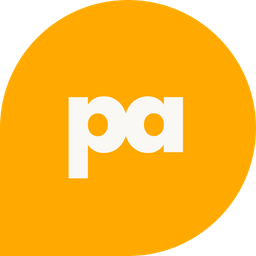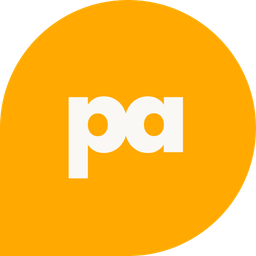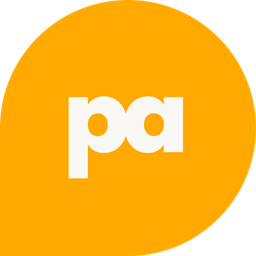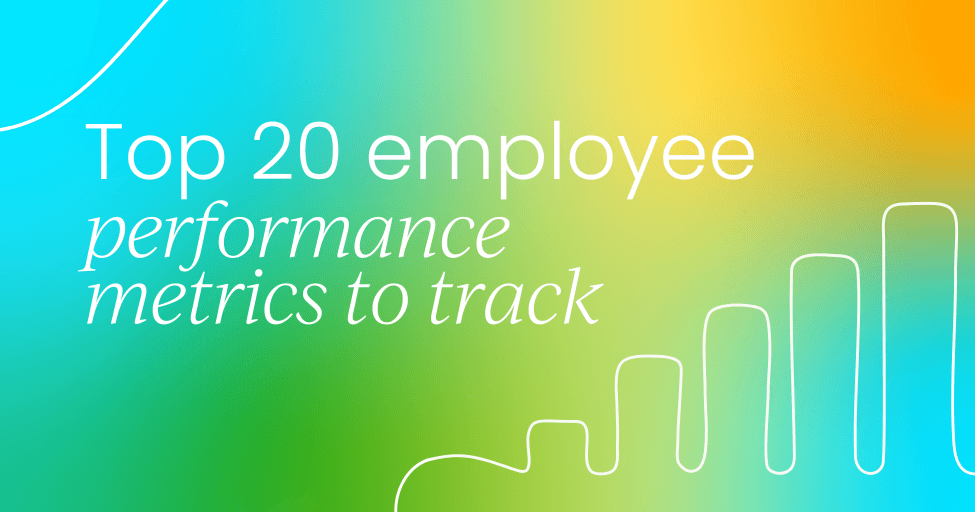To truly understand how your team is performing and identify areas for improvement, you need to know which employee performance metrics to focus on. While it may be tempting to rely on your gut feelings and annual reviews to gauge employee performance, this approach is rarely enough.
Employee performance metrics serve a dual purpose. You can use them for not only measurement, but also to help:
- Create a culture of continuous improvement.
- Identify and retain top talent before they leave.
- Spot development opportunities early.
- Make strategic workforce decisions.
- Align individual performance with business goals.
The challenge, though, is knowing which metrics to track. It’s important to focus on employee performance metrics that align with your business goals while also providing insights into both individual and team performance. This is where some companies miss the mark, which is why we’ve done the heavy lifting for you to bring you 20 of the most useful metrics for evaluating employee performance.
Get ready to discover how these employee performance metrics can help you craft brilliant growth strategies, nurture an even more vibrant company culture, and boost your team's performance.
What are employee performance metrics?
Employee performance metrics are measurable ways to understand how well your people are doing their jobs. They include both quantitative and qualitative measurements and provide a clearer way to assess productivity, efficiency, growth potential, and more.
When using these types of metrics, you’re not just counting how many tasks someone completed or tracking hours worked. Today's performance metrics paint a much richer picture. They might measure how well someone collaborates with colleagues, their ability to solve problems creatively, how they embody company values, or their potential for taking on bigger responsibilities.

The key is choosing metrics that actually matter to your business goals while staying meaningful for your managers and employees. When done right, performance metrics don't just measure success, they help create it.
20 metrics to measure employee performance
Using metrics to measure employee performance is vital to building a productive, motivated workforce. But with so many ways to evaluate output and behavior, where do you even start?
Below are 20 key employee performance metrics to start tracking today:
1. Quality of work
While quantity often steals the spotlight, quality is what keeps customers coming back and reputations strong. This metric reflects how accurate, thorough, and well-executed an employee’s output is.
You can gauge the quality of someone’s work through things like customer feedback, manager reviews, peer assessments, and specific KPIs (like the number of sales, organic traffic numbers, etc.).
A consistent standard of high-quality work is a sign of someone who cares, takes pride in what they do, and brings real value beyond just meeting deadlines.
Measuring the quality of work is also a great way to identify training needs before quality issues escalate any further. To implement this metric successfully, you can try:
- Establishing clear quality standards with measurable criteria for each role.
- Using peer review systems or quality audits for consistent evaluation.
- Scheduling regular quality check-ins rather than annual assessments.
- Creating quality scorecards that employees can self-monitor.
2. Work efficiency
Work efficiency is about more than just speed, it’s the balance between time, effort, and output. But what exactly does an ‘efficient employee’ look like?

Well, you’ll notice that an efficient employee will stand out from the rest because they tend to deliver consistent, high-quality results without unnecessary delays or wasted resources. This metric is especially useful in uncovering where processes can be tightened, where training might be needed, or even where hidden bottlenecks are slowing things down.
To implement this employee performance metric, start by tracking time-to-completion for routine or standardized tasks. Look at the numbers alongside qualitative observations: Is the work still meeting your quality standards? Are shortcuts being taken to hit deadlines?
Finally, benchmark against both industry averages and your internal top performers to set realistic, motivating expectations.
You can measure employee efficiency using this formula:
Employee Efficiency = Working hours / Total hours worked x 100
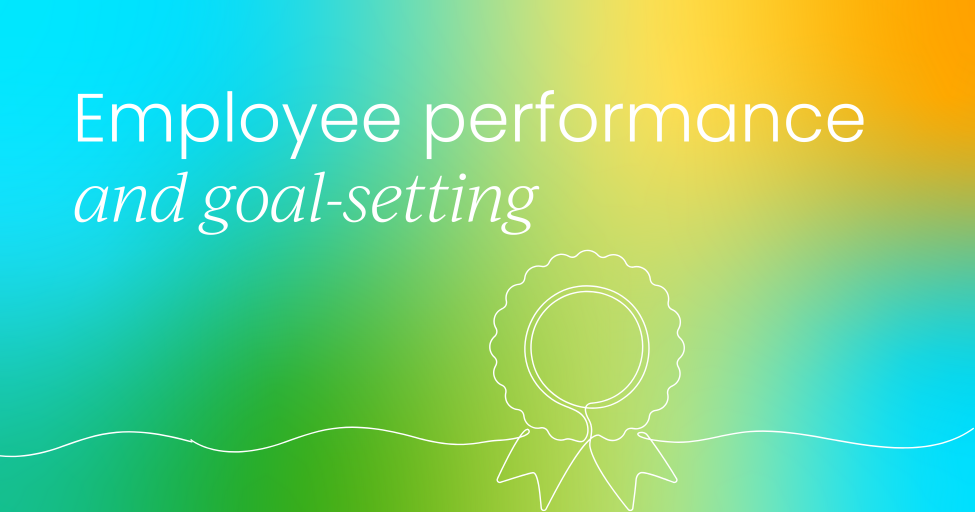
3. Absenteeism rate
Absenteeism, when looked at over time, can be a window into deeper issues like burnout, disengagement, or even workplace culture problems.
Tracking how often an employee misses work (especially without notice) is important. However, you need to remember that the goal here isn’t to penalize but to understand the reason behind the absences.
For example, a spike in absences could be a cry for help or a sign someone’s struggling. Most HR software makes this data easy to access, but the real value comes from pairing it with empathy.
If you notice an increase in absence rates linked to a certain department, it could be a sign of deeper issues such as low morale, poor management practices, or burnout.
An effective way to tackle this issue and find out more is by digging deeper through anonymous surveys or one-on-one conversations to understand what’s really driving the trend.
4. Number of errors
Everyone makes mistakes and it’s normal to have a few missteps in your career. The problem, though, comes when those mistakes are happening very frequently, or they’re repeated errors. Those types of errors can point to a skill gap or attention issue that needs addressing.
Whether it’s data entry mistakes, missed steps in a process, or service delivery problems, tracking how often errors occur can help reveal where support or retraining is needed.
5. Goal achievement
How often an employee meets or exceeds their set goals is a clear signal of performance. But the key is in how those goals are set.
When you’re using SMART goals (specific, measurable, achievable, relevant, and time-bound), achievement becomes not just a yes/no checkbox, but a meaningful indicator of focus, clarity, and alignment.
Keep these goals visible and track progress regularly. And when someone consistently exceeds them? Dig into why. You might find that they may have insights worth spreading across the team.
Tip: Download our SMART Goals Template and help your team turn intentions into well-defined targets that drive accountability and performance.
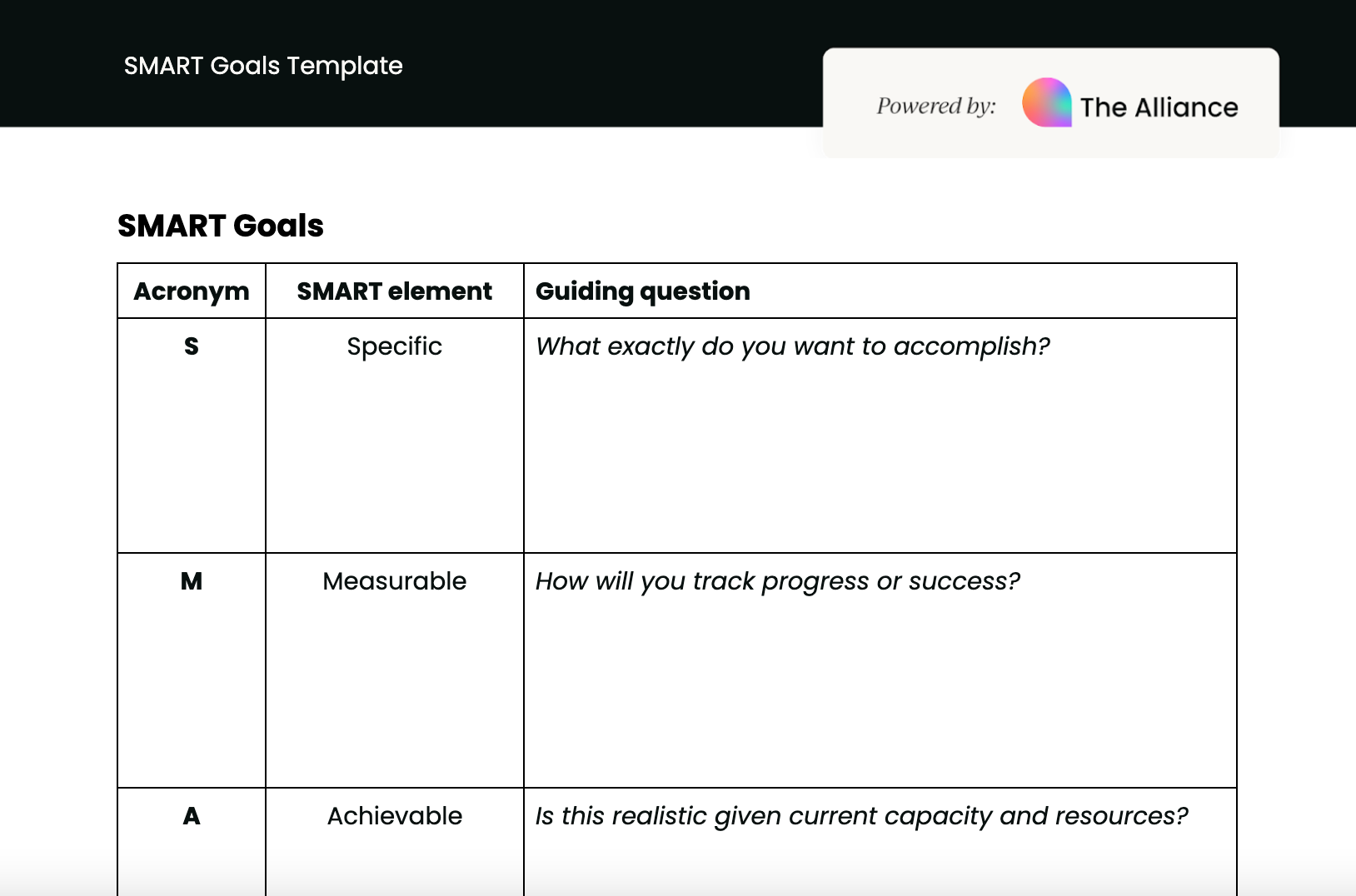
6. Adaptability
Adaptability as a performance metric looks at how well someone responds to change, learns new tools, and shifts gears when priorities evolve.
It’s not always easy to quantify, but you’ll see it in how quickly someone picks up a new platform, embraces process changes, or steps confidently into unfamiliar territory.
You can assess this through manager feedback, training participation, or observing behavior during times of transition.
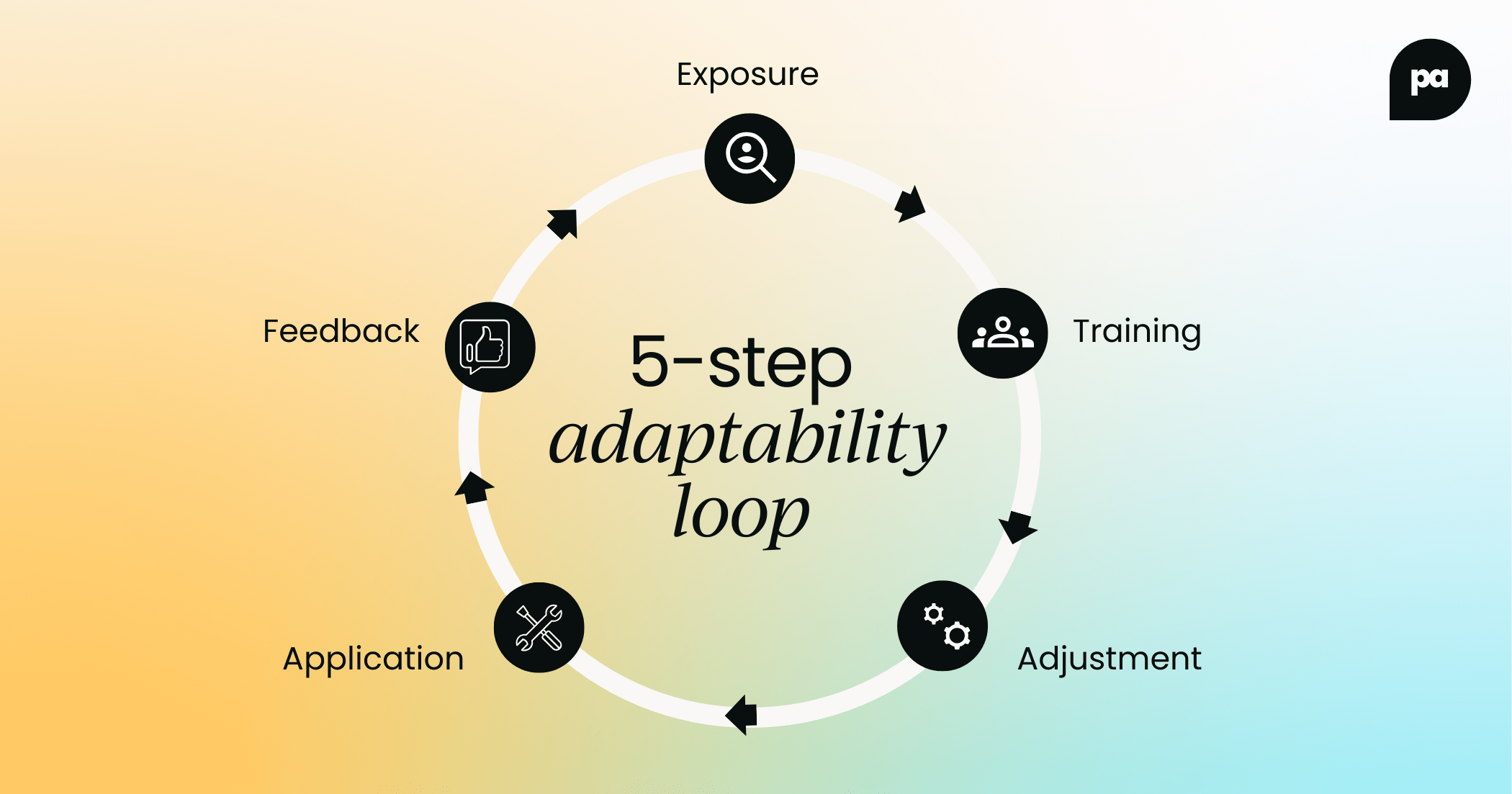
This model illustrates the continuous nature of adapting to change. First, employees are exposed to a new situation. Then, through training, they start to build confidence. Adjustment happens as they test the waters and make sense of the change. Application is where they fully implement new skills or behaviors. And finally, feedback helps refine and reinforce those adaptations.
7. Teamwork & collaboration
The ability to work well with others to share credit, resolve conflicts, and support team outcomes is one of the most valuable workplace traits. If you think this metric is about popularity, think again. In reality, it’s about effectiveness in shared goals.
You can use this metric to help:
- Improve project success rates and team productivity.
- Identify potential leaders and mentors within the organization.
- Reduce interpersonal conflicts and improve workplace culture.
- Support cross-functional project effectiveness.
Some ways to measure this metric include tracking participation in collaborative projects and knowledge sharing and using collaboration tools that provide data on interaction and contribution levels.

8. Time management
When someone consistently hits deadlines, prioritizes well, and avoids last-minute scrambles, it’s usually because they’ve built strong habits around planning and focus. On the flip side, poor time management shows up in missed deliverables, avoidable stress, and reactive workflows.
From an HR standpoint, this is less about clock-watching and more about helping people gain control over their time. You can support this by offering training on prioritization methods (like time-blocking) and encouraging the use of personal task management tools.
Another good way to keep on top of this one is simply checking in during reviews to ask: How do you currently manage your workload? or asking, what’s working or not? Etc.
9. Revenue per employee
This metric measures the average revenue generated per employee within a certain time period. It’s calculated by dividing total revenue by the number of full-time employees. While it’s not meant to evaluate individual employees directly, it helps HR and leadership make smarter headcount, hiring, and resource decisions.
To use this well, track it over time and layer in context.
For example, if revenue per employee is dropping while headcount rises, it might signal underutilized talent or the need to revisit role clarity. Combine it with team-level KPIs to better understand where resources are creating the most value.
Using this metric is good if you want a clear way to demonstrate the ROI of human capital investments and provide benchmark data for things like compensation.
10. Employee engagement
Engagement isn’t about how happy people seem but how connected they feel to their work, their team, and the company’s purpose. Highly engaged employees bring energy, ownership, and resilience to their roles. On the other hand, disengagement can quietly erode performance long before someone decides to leave.
And the impact is significant: according to research, business units in the top half for employee engagement more than double their chances of success compared to those in the bottom half. That means boosting engagement isn’t just good for morale, it’s a real driver of business outcomes.
A powerful way to visualize this is through an engagement pyramid, which breaks employees into three broad tiers:
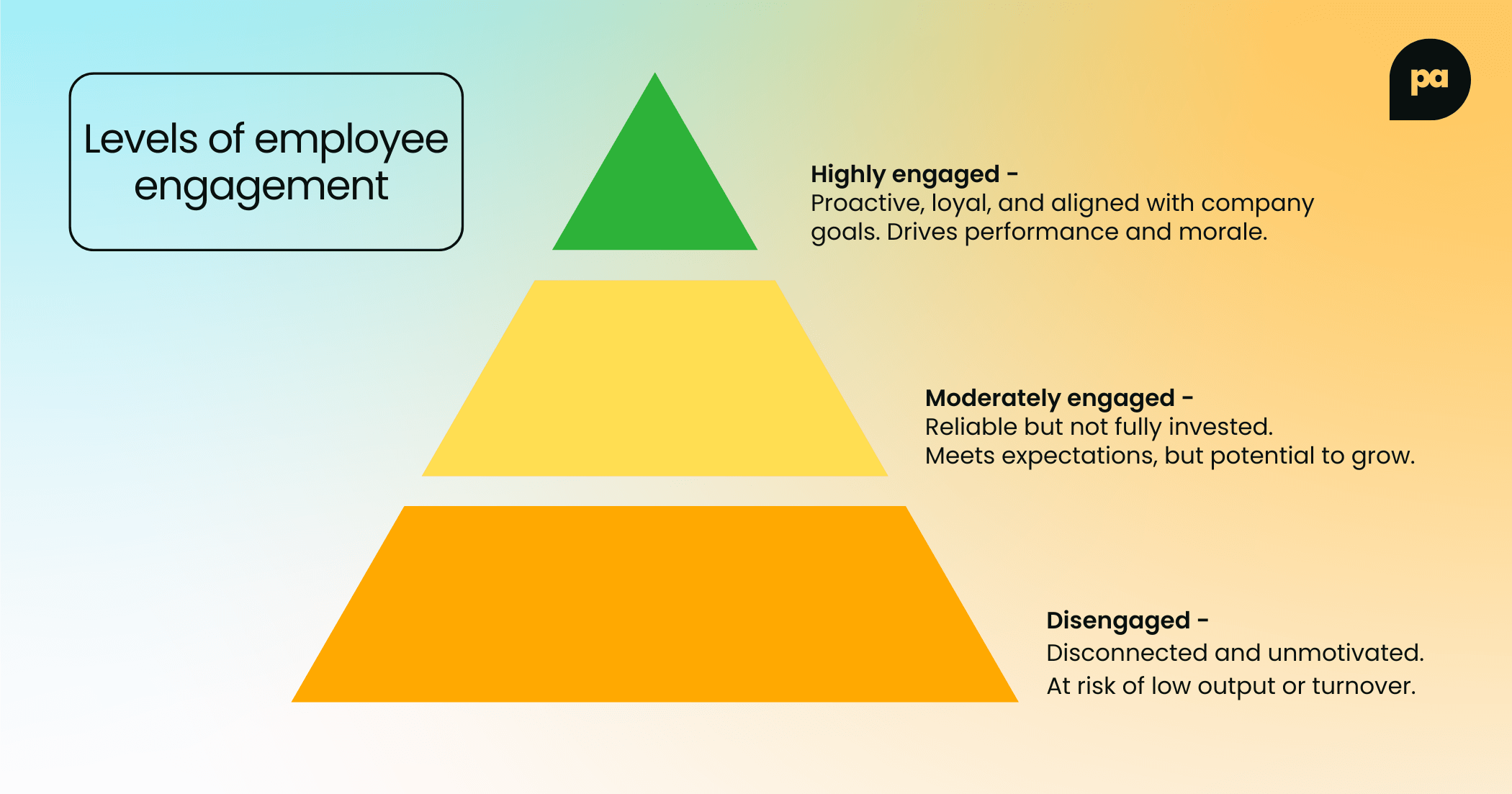
11. Training completion rate
Training completion tells you who’s staying current and who might be falling behind. It’s a useful baseline, especially for compliance topics or onboarding essentials. But beyond box-checking, this metric can reflect a company culture that values learning (or one that doesn’t).
To make training completion meaningful, tie learning modules directly to employee goals or career paths. Don’t just assign courses, but also explain why they matter, and how they connect to success in the role.
Tracking this metric has some real advantages. For example, it:
- Makes sure people stay compliant with any required skills or certifications, especially in regulated roles.
- Helps uncover how employees like to learn, and what might be getting in their way.
- Supports career growth and planning by showing who’s ready to level up or take on new challenges.
- Shows the value of training programs by tying learning back to real performance outcomes.
12. Customer satisfaction (CSAT)
CSAT reflects how satisfied customers are with an employee’s service, usually measured through quick surveys sent right after an interaction. For frontline roles, this is a direct reflection of how well employees are representing the brand, and it’s often the fastest feedback loop available.
From an HR perspective, CSAT can guide development, recognition, and even promotion decisions. Employees with consistently high CSAT scores are often natural communicators, problem-solvers, or relationship builders.
To implement this metric successfully, you could try using standardized survey tools across all customer touchpoints. It helps if you can make sure they’re short, timely, and tailored to the specific interaction, so you gather meaningful feedback without overwhelming customers.
13. Net Promoter Score (NPS)
NPS asks customers one simple question: How likely are you to recommend our company to a friend or colleague?
While it’s often used at a company level, when linked to specific touchpoints or reps, it becomes a performance tool too. Employees who drive high NPS are usually building trust and loyalty, not just solving tickets.
To bring this metric into performance reviews, pair NPS with anecdotal feedback and consider trends over time, not just snapshots. HR can support by training employees in customer experience fundamentals and making sure tools for service or support are working well. If someone’s NPS dips, it’s a chance for coaching, not criticism.
14. Overtime
Regular overtime isn’t always the badge of honor that some may think it is. Sometimes, it’s a red flag. While short bursts can reflect commitment or high-stakes projects, long-term overtime often signals poor resourcing, unclear expectations, or burnout brewing.
Tracking overtime through time sheets or HRIS platforms helps HR spot workload imbalances and prevent attrition.
But rather than discouraging all overtime, ask why it’s happening. Is someone chronically over capacity? Are they staying late due to perfectionism or unclear priorities?
Building a culture that values rest and reasonable boundaries starts with how leaders model behavior, and how HR responds when people feel stretched too thin.

15. Innovation and creativity index
This metric looks beyond routine output to capture how often employees suggest new ideas, improve processes, or contribute creative solutions to challenges. It’s especially useful in roles tied to product development, marketing, or strategy.

As one of the more qualitative metrics to measure employee performance, the innovation index might include things like:
- The number of ideas submitted to innovation programs.
- Participation in brainstorming sessions.
- Involvement in cross-functional initiatives.
HR can also use manager evaluations or peer nominations to recognize creative contributions. Not only does this metric spotlight problem-solvers, but it also encourages a culture where ideas are welcomed and acted on.
16. Project completion rate
This is one of the most practical employee performance metrics examples you can use, especially in project-driven environments. Project completion rate tracks how reliably employees or teams finish assigned projects. It also shows whether they’re delivered on time, within scope, and to a satisfactory standard.
A consistently high completion rate signals accountability, organization, and follow-through.
Tips for implementation:
- Define clear milestones and deadlines for each project to standardize tracking across teams.
- Use completion rates in 1:1s or performance check-ins to highlight follow-through or identify blockers.
- Pair with quality metrics to ensure projects are not just completed, but done well.
17. Internal mobility rate
This metric tracks how often employees move into new roles within the company such as through promotions, lateral shifts, or project-based moves. If you see a strong internal mobility rate, it could signal that your company is committed to career growth and retaining talent.
Here’s a hypothetical example of how using this metric in real life might look:
Let’s say a mid-sized tech company starts tracking internal mobility after noticing high turnover among early-career engineers. By measuring how often these employees are promoted or switch into new technical roles, HR uncovers that most engineers hit a development plateau after 18 months.
In response, they create a new "technical pathways" program that encourages internal applications for specialized roles, paired with mentoring. Within a year, the internal mobility rate for junior engineers increases by 35%, and early attrition drops by nearly half.
Tracking this metric helps uncover talent gaps, support retention, and turn internal hiring into a real part of your growth strategy.
18. Participation in learning and development
One of the most telling metrics to measure employee performance is how actively someone engages in learning opportunities. Participation in L&D shows who’s invested in growing their skill set and adapting to change.
To measure it, look at course enrollment and completion rates, attendance at workshops, or involvement in leadership programs.
Make sure to track not just quantity but also relevance. For example, are employees choosing programs that align with their personal goals and business needs? When there’s alignment on both fronts, the impact can be substantial.
Gartner research shows that employee performance can increase by up to 22% when goals are connected to both business priorities and individual development. This kind of insight helps HR make smarter learning investments and ensures that growth is meaningful at every level of the organization.
19. 360-degree feedback scores
360-degree feedback gives you a well-rounded view of how employees are perceived, not just by their manager, but also by peers, direct reports, and cross-functional partners. It’s especially valuable for evaluating leadership potential, emotional intelligence, and collaboration skills - traits that might not show up in standard performance data.
Surprisingly, though, most companies still lean heavily on manager-only evaluations. In fact, a recent Gartner survey found that while 99% of organizations rely on direct managers to assess performance, only 17% include input from the employee’s wider team. That’s a huge missed opportunity, considering how much impact someone’s behavior and effectiveness have across team dynamics.
By bringing in broader perspectives, 360 feedback helps paint a more accurate and actionable picture, especially when tied to development plans and growth conversations.
Tips for implementation:
- Introduce the process with transparency so employees know what to expect and how feedback will be used.
- Train reviewers on giving constructive, respectful feedback that’s specific and actionable.
- Use follow-up coaching or action plans to help employees turn feedback into real growth.
20. Forced ranking
Forced ranking (sometimes called stack ranking or a vitality curve) is a method of evaluating employee performance by comparing individuals against one another, rather than against static goals.
Typically, employees are grouped into tiers (e.g., top 20%, middle 70%, bottom 10%), and ranked accordingly. The intent is to identify standout performers, average contributors, and those who may need support or may not be meeting expectations.
While controversial, forced ranking can provide clarity when tough decisions need to be made around promotions, raises, or restructuring. It can also spotlight top talent who might otherwise be overlooked in flatter evaluation systems.
However, it should be handled with care because if it’s done poorly, it can demoralize teams or breed unhealthy competition. When done right, it’s one of the more structured metrics to measure employee performance, especially in large organizations where performance calibration is necessary.
Tired of Zoom calls and online meetups?
At People Alliance, community is key so we wanted to supply you with some other options for growing and expanding your network of like-minded customer success professionals.
This is where in-person meetups come in! Never miss out on meetups in your area by joining our Circle page.



 Follow us on LinkedIn
Follow us on LinkedIn